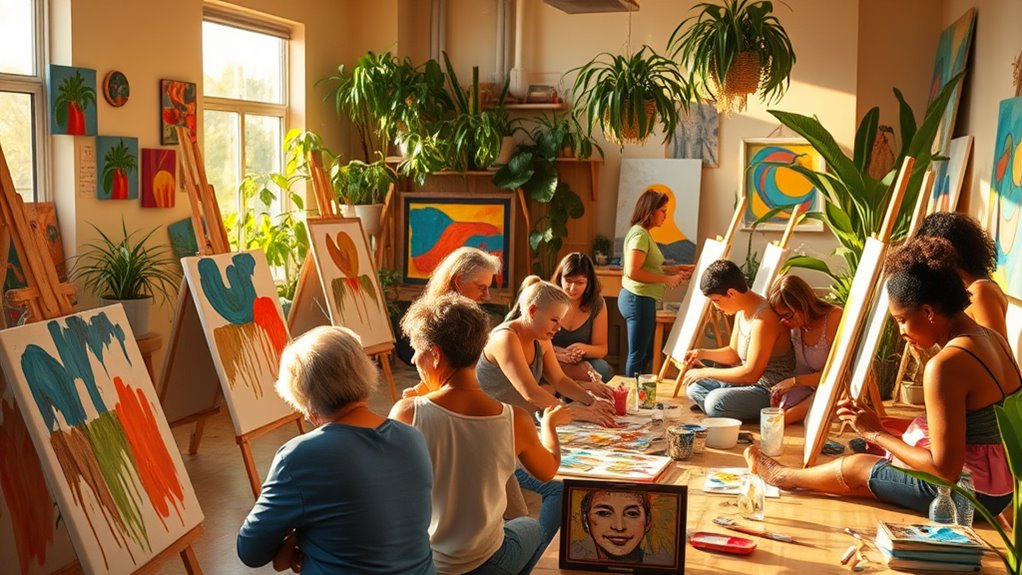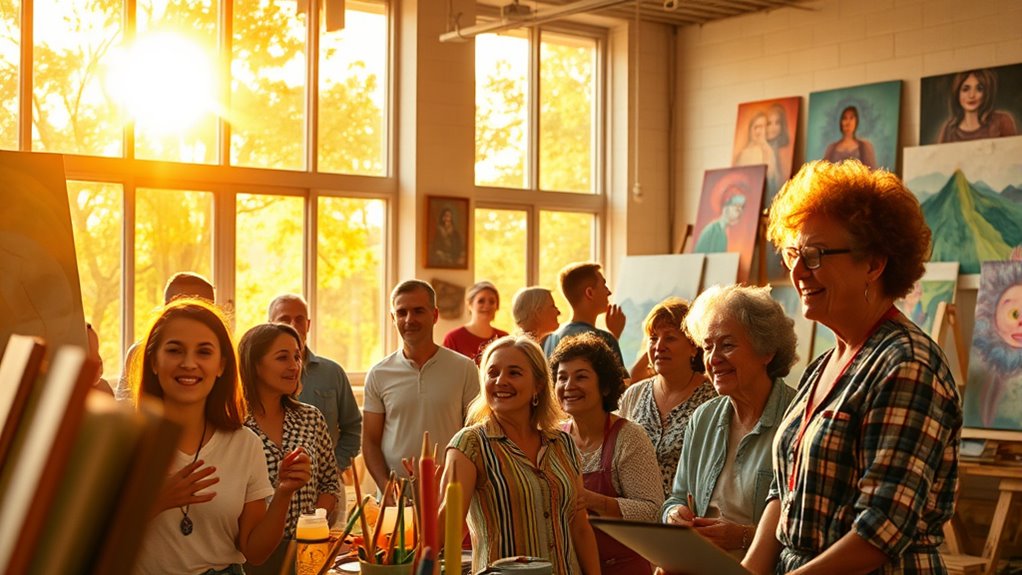Research shows that engaging in art and creative activities can considerably boost your mental health. It reduces stress, lifts mood, and provides an outlet for emotions you might find hard to express. Scientific studies confirm that art therapy and regular creative engagement activate neural pathways linked to positive feelings, helping you build resilience and improve self-esteem. If you want to discover more about how art can enhance your well-being, there’s much more to explore ahead.
Key Takeaways
- Multiple studies confirm that engaging in artistic activities reduces symptoms of depression and anxiety.
- Neural imaging shows art-making activates brain pathways associated with positive emotions and mood improvement.
- Art therapy programs demonstrate significant mental health benefits across diverse populations.
- Regular creative engagement enhances self-esteem and promotes emotional resilience.
- Artistic activities offer accessible, evidence-based tools for stress reduction and overall well-being.

Have you ever wondered how engaging with art can boost your well-being? It turns out, immersing yourself in artistic activities offers more than just aesthetic pleasure; it provides tangible therapeutic benefits that can improve your mental and emotional health. When you participate in creative expression, whether through painting, drawing, or crafting, you’re not just creating something beautiful—you’re also engaging in a process that can help reduce stress, enhance your mood, and foster a sense of accomplishment. Researchers have found that the act of making art activates neural pathways associated with positive emotions, which can lead to decreased anxiety and depression. This isn’t just anecdotal; numerous studies confirm that art therapy and creative pursuits can serve as effective tools for managing mental health issues, especially when traditional treatments aren’t enough. Engaging with art taps into your innate need for self-expression, giving you a safe outlet for emotions that might be difficult to articulate with words. When you pick up a brush or mold clay, you’re translating feelings into visual form, which can be incredibly cathartic. This process of creative expression allows you to process complex emotions, gain insight into your inner world, and build resilience. It’s a form of mindfulness that encourages you to focus on the present moment, helping you break free from negative thought patterns. In this way, art becomes a therapeutic activity, offering a mental space where you can explore your feelings without judgment. The act of creating also boosts your self-esteem, providing a sense of achievement that can counteract feelings of helplessness or low self-worth. Additionally, research shows that engaging in artistic activities can stimulate neural pathways linked to positive emotions, further enhancing mental health. The evidence supporting art’s impact on well-being continues to grow, with studies showing that regular engagement in artistic activities can lead to lasting improvements in mental health. For example, art therapy programs have demonstrated success in reducing symptoms of depression and anxiety among diverse populations. Even casual, non-therapeutic art-making can produce mood-enhancing effects, promoting relaxation and a sense of joy. When you make art, you’re actively participating in a process that nurtures your emotional resilience and helps you cope with life’s stresses. It’s not about creating masterpieces but about embracing the act of expression and the healing potential it holds. Ultimately, integrating art into your routine can serve as a powerful, accessible way to nurture your well-being, making creative expression a valuable tool for a healthier, happier life.
Frequently Asked Questions
How Does Art Influence Mental Health Across Different Age Groups?
Art influences your mental health across age groups by boosting emotional resilience and supporting cognitive enhancement. When you engage in creative activities, you can better manage stress, express emotions, and build resilience to life’s challenges. For children and teens, art helps develop cognitive skills and emotional understanding, while adults and seniors benefit from improved mood and mental sharpness. Overall, art offers a versatile tool to strengthen mental well-being at any age.
What Specific Art Forms Have the Most Significant Impact on Well-Being?
You’ll find that visual arts and performing arts have the most significant impact on well-being. Engaging with visual arts like painting or sculpture can boost your mood and reduce stress, while participating in performing arts such as dance or theater can foster social connection and emotional expression. These art forms actively enhance mental health by encouraging creativity, mindfulness, and community involvement, making them powerful tools for improving your overall well-being.
Are There Cultural Differences in How Art Affects Mental Health?
Yes, cultural differences influence how art affects your mental health. You’re likely to connect more deeply with artistic expressions rooted in your cultural narratives, which can provide comfort and a sense of identity. These cultural contexts shape the meaning you assign to art, affecting its impact on your well-being. Recognizing this helps you appreciate diverse artistic forms and their unique roles in supporting mental health across different cultures.
How Long Do the Positive Effects of Engaging With Art Last?
The positive effects of engaging with art can last from a few hours to several weeks, depending on your level of involvement and personal connection. The duration effects vary, with some experiencing immediate mood boosts, while others enjoy longer-lasting benefits like reduced stress or improved mood over time. To maximize the longevity of benefits, try regular art activities, as consistent engagement deepens emotional impact and sustains positive outcomes.
Can Art Therapy Replace Traditional Mental Health Treatments?
You might wonder if art therapy can replace traditional mental health treatments. While art therapy effectiveness varies, studies show it markedly reduces anxiety and depression, making it a valuable mental health alternative. With over 75% of participants reporting improved well-being, art therapy offers a complementary approach. However, it’s not a one-size-fits-all replacement but a powerful tool that works alongside conventional treatments to support mental health.
Conclusion
You might be surprised to learn that engaging in artistic activities can boost your mood by up to 25%. This research shows that art truly has a powerful impact on well-being, helping you reduce stress and increase happiness. So, next time you pick up a paintbrush or listen to your favorite music, remember you’re actively supporting your mental health. Embrace art’s potential—you might just find it makes your days brighter and more fulfilling.









